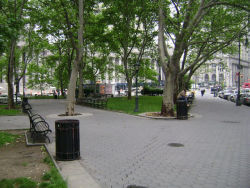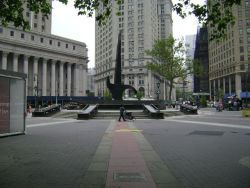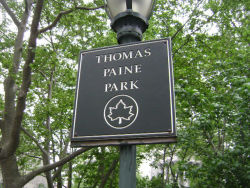Thomas Paine Park
Foley Square
This park in the heart of New York City's civic center is named for patriot, author, humanitarian, and political visionary Thomas Paine (1737-1809). The land that is now Thomas Paine Park was once part of a freshwater swamp surrounded, ironically, by three former British prisons for revolutionaries. One of them was The Bridewell, the infamous detention center where many inmates died from wind and cold exposure while awaiting sentencing. After the war, the area went through more hard times. In the 19th century, it was part of one of the most notorious slums in the country: Five Points, a community of predominantly Irish immigrants. After calls for reform, the City acquired and condemned most of the unsafe buildings between 1887 and 1894.
The City acquired this site, located between Lafayette, Worth, and Centre Streets within what is now called Foley Square, on August 5, 1913 and transferred title to Parks on March 19, 1930. Before this acquisition, it was known simply as the "Courthouse Plot" because of its proximity to several State and Federal court buildings.
In 1977, through the initiative of City Council President Paul O'Dwyer, the Council renamed the parcel at New York's center of law and justice Thomas Paine Park. In 2000, several adjacent streets were eliminated to unite the parcels that make up Foley Square. Following this renovation, Thomas Paine Park was officially integrated into Foley Square and rededicated.
In 2013, George Edwin Bissell’s sculpture of Abraham De Peyster (1657-1728), former New York City mayor (1691-1694), was reinstalled in the park. The relocation of this sculpture, which was originally cast in 1896, to this downtown park is particularly apt given its historical associations to early Dutch settlement and later immigrant arrivals. On July 8, 2014, the 357th anniversary of de Peyster's baptism, the sculpture was rededicated in the presence of more than two dozen de Peyster descendants, city officials, and the Netherlands Consul General.
The park’s namesake, Thomas Paine, was an Englishman from Thetford in County Norfolk. He spent his early years committed to justice in Britain, speaking out for social equity and lobbying for higher wages. In 1774, at the urging of Benjamin Franklin, then colonial ambassador to Britain, Paine immigrated to Philadelphia. He became a close associate of Franklin, the other founding fathers, and the Marquis de Lafayette. His writings profoundly influenced the course of the American Revolution and the creation of the United States government.
Paine published the unsigned pamphlet Common Sense on January 10, 1776. It advocated rising up in arms against Britain, and many of its ideas are echoed in the Declaration of Independence. His description of representative government became the basis for modern democracy anchored by a written constitution. Paine's sixteen American Crisis essays boosted morale during the darkest days of the Revolutionary War. For his service to the fledgling nation, New York State later gave Paine a 277-acre farm in New Rochelle, New York.
His most famous work, Rights of Man (1791), was written after the French Revolution and proposes that government is responsible for protecting the natural rights of its people. Many of Paine's ideas were strikingly far sighted. He advocated for the abolition of slavery, defended freedom of thought and expression, and proposed an association of nations to avert the spread of conflicts.
In 1802, Paine returned to America, where he was the guest of President Jefferson, to whom he recommended the Louisiana Purchase. Paine tried to settle down on his farm, but his declining health led him to move to Manhattan in 1804. He died in Greenwich Village on June 8, 1809. His remains were buried on his New Rochelle farm. It was not until several years after his death that dedicated friends and biographers began to remind the public of Paine's contributions to American freedom and democracy.
"My country is the world, and my religion is to do good." - Thomas Paine, Rights of Man Part Two (1792)
Check out your park's Vital Signs
Clean & Safe
Green & Resilient
Empowered & Engaged Users
Share your feedback or learn more about how this park is part of a
Vital Park System



